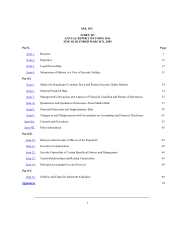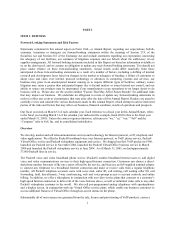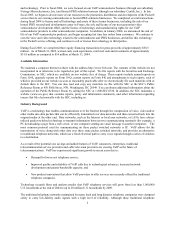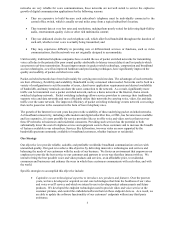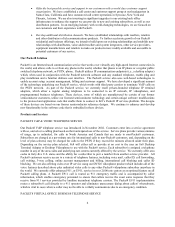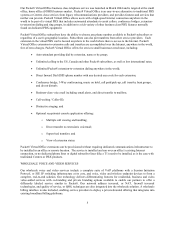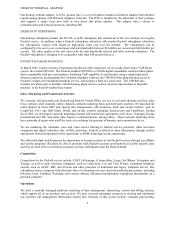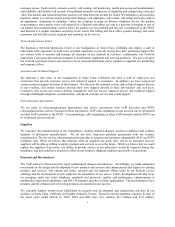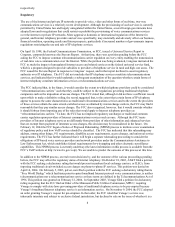8x8 2005 Annual Report Download - page 13
Download and view the complete annual report
Please find page 13 of the 2005 8x8 annual report below. You can navigate through the pages in the report by either clicking on the pages listed below, or by using the keyword search tool below to find specific information within the annual report.10
providers of voice telephony creates unfair competitive advantages, if the regulatory framework governing the
provision of VoIP should vary based on the market served and whether VoIP providers should be subject to the
current system of intercompany compensation arrangements. The CPUC has indicated that this process could last up
to 18 months, but there is no way for us to predict the timetable or outcome of this process. On April 7, 2005, the
CPUC instituted a rulemaking to assess and revise the regulation of all telecommunications utilities in California
except for small incumbent local exchange carriers, or ILECs. The primary goal of this proceeding is to develop a
uniform regulatory framework for all telecommunications utilities, except small ILECs, to the extent that it is
feasible and in the public interest to do so. While not specifically directed at VoIP, it is unclear at this time what
impact this new rulemaking will have on the CPUC’s classification or treatment of VoIP services.
In May 2004, in response to a 2003 complaint case brought by Frontier Telephone of Rochester against Vonage, the
New York State Public Service Commission, or NYPSC, concluded that Vonage is a telephone corporation as
defined by New York law and must obtain a Certificate of Public Convenience and Necessity, which represents the
authorization of the NYPSC to provide telephone service in New York. Under this ruling, Vonage would be required
to provide 911 service in some form, and would be required to file a schedule of its rates. Vonage appealed this
decision and, in June 2004, a federal judge issued a preliminary injunction enjoining the NYPSC from regulating
Vonage as a telecommunications carrier. Vonage has asked the federal district court to make this a permanent
injunction, and this request is being considered. While this ruling applies only to Vonage and not to us, if we are
subject to regulation by the NYPSC, we may become subject to liabilities and may incur expenses that adversely
affect our results of operations.
In July 2004, we received a letter from the Arizona Corporation Commission (ACC) stating that it was conducting a
competitive analysis of the various telecommunications markets in Arizona. The letter requested that we provide
answers to a listing of questions as well as certain data. On August 26, 2004, after executing the ACC's standard
protective agreement governing the submission of commercially sensitive information, we sent to the ACC answers
to some of the questions posed in the initial letter, together with information responsive to certain of the data
requests. Inasmuch as the ACC proceeding is a generic docket opened for the purpose of gathering information
regarding VoIP, additional information requests are possible, but none has been received to date.
In July 2004, the Internal Revenue Service issued an Advance Notice of Proposed Rulemaking to determine whether
to propose regulations that would revise the existing Federal Excise Tax requirements to reflect changes in
communications technologies. Additionally, there are several amendments to the Internet Tax Freedom Act, or
ITFA, pending in the federal legislature that aim to expressly exclude VoIP from the tax freedom enjoyed by
Internet services under the ITFA.
In August 2004, the FCC released a NPRM to examine the applicability of CALEA on VoIP and broadband
services. In the CALEA NPRM, the FCC made certain tentative conclusions that if adopted could impose CALEA
obligations on VoIP and broadband services and providers such as us. Complying with CALEA requirements may
impose additional substantial costs on us.
In November 2004, the FCC ruled that the VoIP service of a competitor and "similar" services are jurisdictionally
interstate and not subject to state certification, tariffing and other legacy telecommunication carrier regulations. The
FCC ruling has been appealed by several states and the outcome of these appeals cannot be determined at this time.
In late 2004 and early 2005, we received notices from multiple municipalities in California that the Packet8 service
is subject to utility user taxes, as defined in the respective municipal codes. The notices require that we begin
collecting and remitting utility user taxes no later than January 1, 2005. We have responded to these municipalities
and disputed their assertions.
In January 2005, we received a letter from the Municipal Association of South Carolina, or MASC, an association
representing multiple municipalities in South Carolina. The MASC asserts that we are subject to a business license
tax applied to telecommunications companies doing business within the participating municipalities’ corporate
limits. We have responded to the MASC and disputed their assertion.
In May 2005, we received a notice from the City of Chicago that we were being investigated for non-compliance
with Chicago tax laws as we are not collecting and remitting Chicago’s Telecommunications Tax. We are working
with counsel to formulate a response to dispute the applicability of this tax to the Packet8 service.
Most recently, on May 19, 2005, the FCC unanimously adopted an Order and NPRM that requires VoIP providers to


